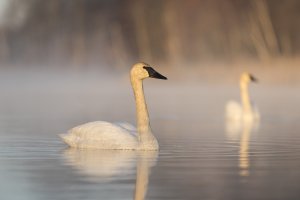Bird of the Week: Trumpeter Swan
 As the largest waterfowl in North America, the Trumpeter Swan is an elegant sight in flight and on water. This native bird can be found in Great Lakes and Midwest states, often in more wild habitats with shallow water such as marshes, ponds or lakes. The swans create nests atop muskrat and beaver lodges in these wetland areas, and feed on aquatic plants around them. Young swans, called “cygnets”, are able to swim within the first 24 hours of hatching. Due to their large size, Trumpeter Swans are experts at the 100-meter dash – while not winning with speed, they need this distance as their “runway” on the water’s surface to lift them into flight! Distinguish these swans from the more common, invasive Mute Swan, by its all black bill. Trumpeter Swans were once over-hunted for their feathers, and areas of their wetland habitat was destroyed, taking the population down to less than 100 individuals south of Canada in the early 1900s. Through hunting protection, habitat conservation, and reintroduction efforts, the species was able to come back as a conservation success story. Ongoing conservation efforts are important for these swans still, since they are sensitive to human disturbance. To learn more about the Trumpeter Swan, visit https://www.allaboutbirds.org/guide/Trumpeter_Swan/overview. Happy birding!
As the largest waterfowl in North America, the Trumpeter Swan is an elegant sight in flight and on water. This native bird can be found in Great Lakes and Midwest states, often in more wild habitats with shallow water such as marshes, ponds or lakes. The swans create nests atop muskrat and beaver lodges in these wetland areas, and feed on aquatic plants around them. Young swans, called “cygnets”, are able to swim within the first 24 hours of hatching. Due to their large size, Trumpeter Swans are experts at the 100-meter dash – while not winning with speed, they need this distance as their “runway” on the water’s surface to lift them into flight! Distinguish these swans from the more common, invasive Mute Swan, by its all black bill. Trumpeter Swans were once over-hunted for their feathers, and areas of their wetland habitat was destroyed, taking the population down to less than 100 individuals south of Canada in the early 1900s. Through hunting protection, habitat conservation, and reintroduction efforts, the species was able to come back as a conservation success story. Ongoing conservation efforts are important for these swans still, since they are sensitive to human disturbance. To learn more about the Trumpeter Swan, visit https://www.allaboutbirds.org/guide/Trumpeter_Swan/overview. Happy birding!
